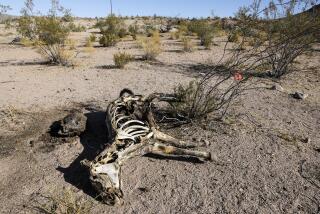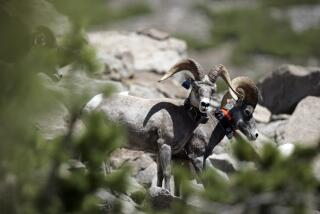Wild horse advocates say 1,300 in BLM roundup is still too many

The overheated debate between the federal government and animal advocates over the removal of wild mustangs from the Western range ticked a few degrees higher after the Bureau of Land Management announced plans to take fewer horses from the land this summer.
Even though its holding capacity for captured wild horses has nearly reached its limit at 50,000 animals nationwide, the agency said last week that it would remove 1,300 horses in the coming months, many of which might otherwise die from lack of food and water.
Animal advocates say 1,300 horses is still too many, and question the BLM’s rationale for the removals.
Nine of the BLM’s 16 summer roundups will be conducted in Nevada, home to roughly half of the estimated 37,000 free-roaming wild horses and burros in the West. The agency plans to remove 855 wild horses and burros in Nevada, 140 in Oregon, 105 in Arizona, 65 in New Mexico, 50 in Colorado and 25 in Idaho, the agency said in a news release.
On Tuesday, the agency said it would relocate 50 wild horses threatened by drought from an area two hours north of Las Vegas. BLM officials said “it is anticipated that as an act of mercy, some animals with a poor prognosis for survival may need to be humanely euthanized to end their suffering.”
“The drought conditons are so severe we’re going to see die-offs,” BLM spokesman Tom Gorey told the Los Angeles Times.
The BLM has been closely monitoring drought conditions and since early July has been supplementing the natural water seeps, filling tubs and troughs with water and providing hay to the horses. Unfortunately, these animals are extremely skittish and will not drink from the man-made containers. Even with the extra water, the seeps do not provide enough water to sustain them, Gorney said.
“It’s contrary to the cliche -- we’re bringing the water to the horse, but the animals still won’t drink it,” he told The Times. “Horses will die. It’s not going to be pretty.”
The BLM has been under fire for what many have called its failing policies toward wild horses, who have been blamed for range damage despite the fact that their numbers are heavily overshadowed by grazing domestic cattle.
An independent scientific review of the agency’s horse roundups, released in May, recommended that the government invest in widespread fertility control of the mustangs and let nature cull any excess herds instead of spending millions to house them in overflowing holding pens.
The 14-member panel assembled by the National Academy of Sciences’ National Research Council and Management concluded BLM’s removal of nearly 100,000 horses from the Western range over the last decade is probably having the opposite effect of its intention to ease ecological damage and reduce overpopulated herds.
In June, 30 member os the House of Representatives urged new U.S. Interior Secretary Sally Jewell to reform the government’s wild horse management program and its spiraling budget, which is dominated by the high cost of corralling and removing the animals from the range.
For the 2013 fiscal year, which ends in September, the BLM plans to remove 4,800 mustangs from the range, compared with 8,255 in the last fiscal year, Gorey said, adding that the reduction is due to overstocked corrals.
In a statement, the American Wild Horse Preservation Campaign coalition criticized the BLM’s plans.
“The BLM is galloping ahead with rounding up more wild horses, despite the high cost to taxpayers and animals as well as the findings of an independent scientific review, which recommends against continued roundups,” said coalition spokeswoman Suzanne Roy. “The agency still has not gotten the message that the removal of wild horses from our Western public lands is inhumane, unsustainable, unscientific, and must come to an end.”
Six of the Nevada roundups will employ contract helicopters to drive the animals to pens, while the rest of the operations will use bait and water to trap them in corrals.
Sally Summers, founder of the Reno-based group Horse Power, which has called for a stop to the capturing of horses and burros, said the BLM’s planned areas for its water traps is the same area that is at the center of a lawsuit by advocates for better monitoring access of helicopter roundups.
“They’re doing water traps because they knew we won’t have access to monitor what they’re doing,” Summers told The Times. “Do they make sure there is enough water in those traps? Do they check them enough times a day to collect horses out in the middle of the heat? We won’t know, because they won’t let us near those traps to watch their tactics.”
She added: “The BLM is tired of people picking it apart. They want to do what they do in secrecy.”
Gorey lashed back at critics.
“The opponents of our horse gathers face a daunting question of ethics,” he told The Times. “On one hand, they imply that if Mother Nature kills off the horses from thirst or starvation, that’s OK. But if we intervene to save these horses, that’s unacceptable.”
“Where is the reasoning in that argument. I don’t see it.”
ALSO:
Loose rules leave Six Flags to investigate itself for park death
Federal judge temporarily blocks North Dakota’s new abortion law
Cleveland-area man charged with kidnapping, murdering 3 women
More to Read
Start your day right
Sign up for Essential California for news, features and recommendations from the L.A. Times and beyond in your inbox six days a week.
You may occasionally receive promotional content from the Los Angeles Times.







